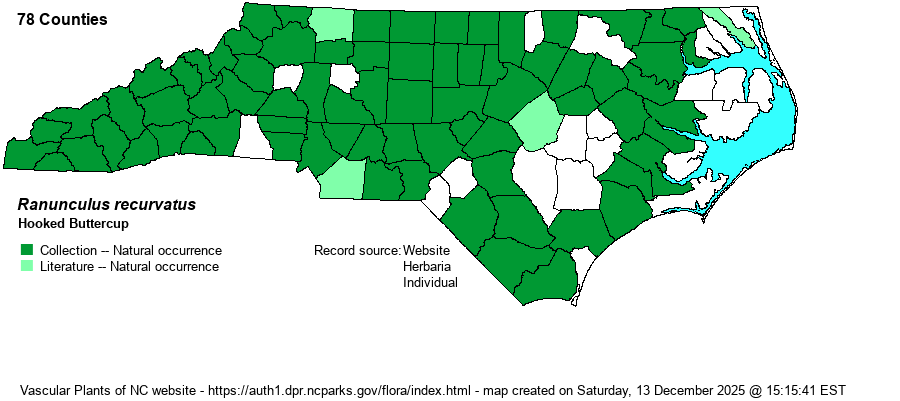| Author | Poiret | |
| Distribution | Throughout the Mountains and Piedmont; present over nearly all of the Coastal Plain except very rare to absent in the extreme eastern areas -- no records east of Martin, Beaufort, and Craven counties.
This is a very widespread species from southeastern Canada south to the FL Panhandle and eastern TX. It is found in most counties within this large range. | |
| Abundance | Common in the Mountains and Piedmont; fairly common to locally common in the western and central Coastal Plain; rare in the Sandhills proper; very rare in the far northeastern counties. The cluster of six counties in the middle of the Coastal Plain lacking records may be a fluke and an artifact of collecting, though the species is obvious not common in this region. | |
| Habitat | This is a species of shady places in moist or rich soil. It grows best on rich slopes or in bottomlands, but it can grow upslope onto mesic slopes as well as in swamps. It is most often seen in Rich Cove Forests and in Mesic Mixed Hardwood Forests. It often grows in the same places, and often is as equally common, as the "large-flowered" R. hispidus. | |
| Phenology | Blooms from April to June, and fruits shortly after flowering. | |
| Identification | This is a fairly low buttercup, somewhat similar in growth form and in leaf characters as the larger-flowered R. hispidus. This species, which also is quite hairy/hispid on the petioles, has several basal leaves on fairly long petioles. Each blade is strongly cut/divided into 3 segments, each strongly toothed at the ends and serrated on the margins; each leaf is about 3 inches long and wide. The several flowering stalks can grow to 1.5 feet tall, quite hairy, and with a few stem leaves that are fairly large and dissected into 3 segments like on the basal leaves. The upper portions of the stems are branched, with tiny flowers topping each branch. The flower contains 5 pale yellow petals, each only about 1/5-inch long. The green sepals are about the same length; thus, a spread flower is only about 2/5-inch across. The scientific and common names refer to hooks on the achenes (seeds), in the small, clustered fruit "ball" -- not really needed as an identification feature unless the plants are found after flowering is completed. Otherwise, biologists walking though moist forests in spring will often run onto both this species and R. hispidus, and though the leaves can look rather similar, this species has the very small flowers with pale yellow petals as compared with the relatively large, bright yellow, and showy flowers of R. hispidus. Also, this species typically carries the basal leaves higher off the ground, frequently 6 inches or more, whereas the basal leaves of R. hispidus are usually close to the ground. | |
| Taxonomic Comments | Weakley has varieties for this species, with the nominate one -- R. recurvatus var. recurvatus -- being the only one in NC.
| |
| Other Common Name(s) | Hooke Crowfoot, Blisterwort | |
| State Rank | S5 | |
| Global Rank | G5 | |
| State Status | | |
| US Status | | |
| USACE-agcp | FACW link |
| USACE-emp | FAC link |

